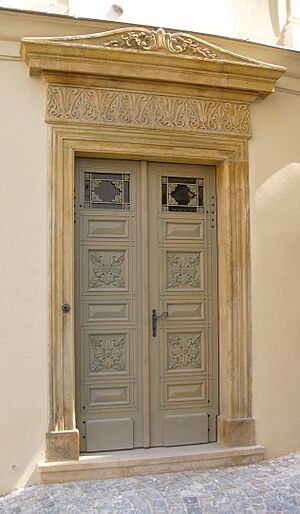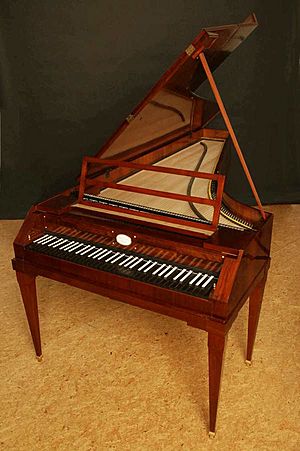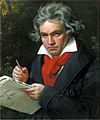Classical period (music) facts for kids
The Classical period in Western music happened between about 1730 and 1820. This was a time when music changed a lot. People often use the term classical music to mean all Western art music, from the Middle Ages until today. But the Classical period is a specific time.
This period came after the Baroque period and before the Romantic period. Classical music sounds lighter and clearer than Baroque music. It's also usually less complicated.
Some of the most famous composers from this time are Joseph Haydn, Wolfgang Amadeus Mozart, and Ludwig van Beethoven. Other important composers include Franz Schubert, Luigi Boccherini, and Johann Christian Bach. Ludwig van Beethoven is sometimes seen as a Romantic composer. But he also helped music move from the Classical to the Romantic era.
Contents
What is Classicism?
Around the middle of the 18th century, Europe started a new style. It was called Classicism. This style appeared in architecture, books, and art. It tried to copy the ideas of ancient Greece and Rome. Classical music was still very connected to the royal courts and rich families.
Changes in how people earned money and lived also helped this new style grow. As the 18th century went on, rich families became the main supporters of music without singing. People also started to like lighter, funny comic operas more.
Even though comic operas were popular, music without singing became very important. The main types of instrumental music were the sonata, trio, string quartet, symphony, and concerto. A concerto usually featured one solo instrument with an orchestra. Lighter pieces like serenades and divertimentos were also popular. The sonata form became very important. It was used for the first part of most big pieces like symphonies and string quartets.
When Mozart came to Vienna in 1780, the Classical style grew even faster. Mozart mixed the bright Italian style with the strong German style. People started to see that Haydn and Mozart were writing amazing music. During this time, Mozart wrote his most famous operas and his last six symphonies. He also wrote many piano concertos that are still loved today.
Instruments of the Classical Period
String Instruments
In the Baroque era, there were many different string instruments. But in the Classical period, the string section of the orchestra became more standard. It usually had four main instruments:
- Violin: In orchestras and chamber music, there are first and second violins. First violins often play the main tune. Second violins play harmony or accompaniment.
- Viola: This is the middle voice of the string section. It often plays "inner voices," which are harmony parts that fill out the music.
- Cello: The cello plays two roles. Sometimes it plays the bassline (the lowest part), often with the double bass. Other times, it plays melodies or solos in a lower sound.
- Double bass: This instrument usually plays the very lowest notes in the string section. It provides the deep bassline for the music.
Woodwind Instruments
Keyboard Instruments
- Clavichord
- Fortepiano: This was an early version of the modern piano.
- Piano
- Harpsichord: This instrument was common in the Baroque era. It was used until the 1750s. Then, the fortepiano and later the piano replaced it. By the early 1800s, the harpsichord was not used anymore.
Brass Instruments
- Buccin
- Ophicleide: This instrument replaced the "serpent". It was an early version of the tuba.
- French horn
- Trumpet
- Trombone
Women in Music
Most music books about the Classical period focus on male composers. Their music is often played in concerts today. However, there were many women composers during this time.
Images for kids
-
A modern string quartet. In the 2000s, string quartets from the Classical era are the core of the chamber music literature. From left to right: violin 1, violin 2, cello, viola
-
Gluck, detail of a portrait by Joseph Duplessis, dated 1775 (Kunsthistorisches Museum, Vienna)
-
Haydn portrait by Thomas Hardy, 1792
-
The opening bars of the Commendatore's aria in Mozart's opera Don Giovanni. The music starts with a harsh-sounding chord.
-
Portrait of Beethoven by Joseph Karl Stieler, 1820
-
View of Vienna in 1758, by Bernardo Bellotto
-
Wolfgang Amadeus Mozart (seated at the keyboard) was a child prodigy who played the piano and violin very well. He was known as a gifted performer and improviser.
See also
 In Spanish: Música del Clasicismo para niños
In Spanish: Música del Clasicismo para niños














